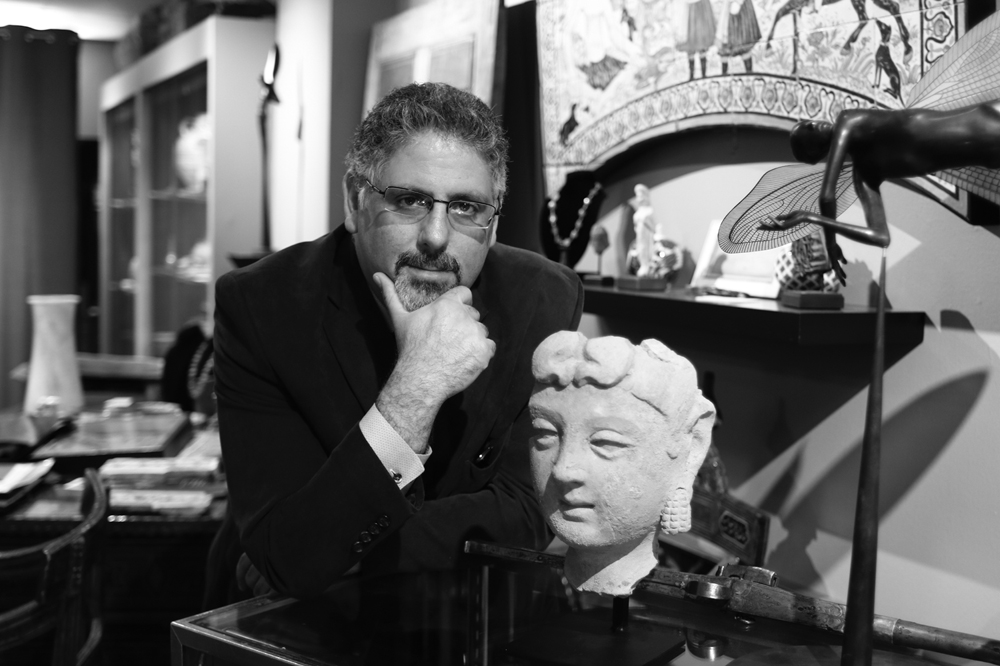
Paul Anavian, managing director, Manhattan Art & Antiques Center.
With 100 galleries representing just about every category of arts and antiques one can think of, the Manhattan Art & Antiques Center (MAAC), located on Second Avenue between 55th and 56th Streets, is celebrating its 40th anniversary since its founding in 1974. Paul Anavian is a second-generation dealer specializing in ancient and Islamic works of art. His father, Habib Anavian (1915–1995), came to the United States from Iran in the 1950s and founded the family business, now a staple gallery within MAAC. Paul Anavian is also managing director of MAAC, and he recently shared some news about exciting changes at the emporium with Antiques and The Arts Weekly
Q. Tell us a bit about the changes being made at MAAC.
A. We’re trying to increase the quality of our vendors and institute new programs, such as a series of educational initiatives, both on the web and in-house. I have contacts at the New York School of Interior Design, along with friends and scholars in the field, that I am reaching out to begin a lecture series that would be designed to instruct the public on how to buy antiques, collect art, recognize reproductions and general topics related to the world of art and antiques. We also have a new café coming soon and are making major changes in our overall advertising and PR strategy to attract new visitors.
Q. You say that increasing the quality of your tenant vendors is one of your priorities. How do you ensure that that happens?
A. You really have to go by the reputation of the dealer. In the art world, from the bottom to the top, even in the major auction houses, you always have artworks that slip through the cracks, that may not be as described, maybe fake or misattributed. But if you’re dealing with a reputable individual who will stand behind what they sell, then that’s really the goal of any establishment.
Q. You’re also involved with the Asia Art Fair, spring and fall, also in New York City, right?
A. Yes, for the past two years I have been art director for the Asia Art Fair conducted during Asia Week in March. I have been working with the Bohemian National Hall and the Bohemian Benevolent & Literary Association, who sponsor the show. This fair houses many top galleries from around the world specializing in Asian art. There are plans for a Contemporary Asian Art Fair this coming November 2–4, coinciding with Contemporary Asian Art Week here in town.
Q. What kinds of things are you planning to mark the center’s 40th anniversary?
A. It’s in the planning stages right now, but we want to make it a gala event.
Q. Will it be tied into any particular thing going on in the city?
A. That’s what we’re working out now. We’re trying to see what the best time would be.
Q. How many “charter” dealers do you have at the center?
A. Charter members? We probably have about two or three — Hemingway was one of the first, Ray Chen is another… then we have many who have been here for more than 30 years.
Q. How long is your own association with MAAC?
A. I’ve been a tenant here for 13 years myself, specializing in ancient and Islamic works of art.
Q. Middle Eastern art has been in the news lately as endangered by terrorism and sectarian turmoil. Do you believe there’s enough world interest and leverage to protect antiquities there?
A. I think there is a strong world interest. The trouble is, how to protect the art, because in order to protect it you have to get in there and confront those who are destroying it. It’s hard to even just stop small bands of these people who just destroy things right there — taking faces off of statues. That’s predominantly what they do — anything with a figural representation they destroy. There’s no honoring of the past cultures.
Q. How did you become interested in ancient Near Eastern and Islamic Art?
A. I grew up in the field. My father was an antiquities dealer, quite prominent, especially in Iranian art, with clients like Arthur Sackler, the Met and many other major museums.
Q. So that started you on the road to collecting?
A. Well, you are always collecting things, here and there, that you want to keep. But growing up with it, I always had an affinity for it, enjoyed it and when I came to terms with how to deal with a father who owned the business [chuckles], settling down, just saying “yes” to everything, working together, it grew from there.
Q. What is one of the most rare or interesting pieces in your collection?
A. Some of the rare pieces I have are early gold bracelets, for example, circa 1000 BCE, early pottery and cylinder seals, which are very important, circa 4,000 BCE, and Islamic works of art, like early Turkish Iznik and some early Persian pieces. I’m very object-oriented. I have some paintings, some calligraphy, but I’ve always been drawn to objects.
Read article and see more images inside June 26, 2015 E-edition

